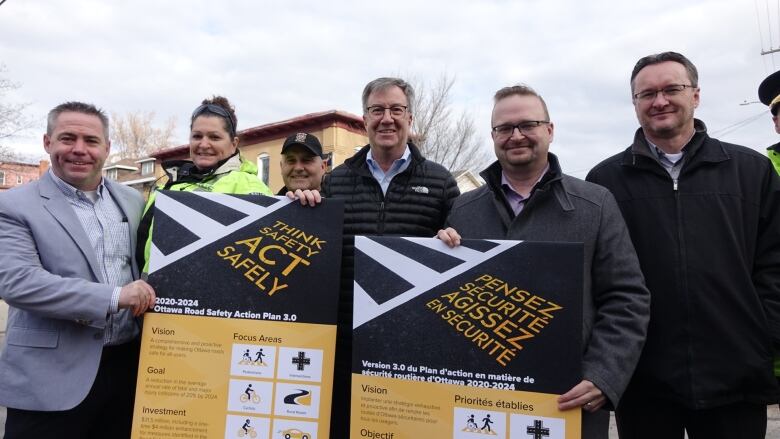Road safety plan sets sights on reducing injuries, deaths by 20%
City to pour $31.5M into segregated bike lanes, more traffic lights

It's not quite "Vision Zero," but the latest investment in Ottawa's push toward safer roads for pedestrians, cyclists and drivers is a step in the right direction, Mayor Jim Watson said Monday.
"This plan aims to continue progress towards zero fatalities or major injuries on our roadways, and has a goal of reducing by 20 per cent the average annual rate of fatal and major injury collisions by 2024,"Watson announced at the corner of Gladstone Avenue and Bay Streets, where new traffic lights will soon be installed.
The city will invest $31.5 million investment over the next four years, beginning in 2020, including a one-time cash infusion of $4 million for various infrastructure improvements.
TheRoad Safety Action Plan 2020 2024 identifies four major priorities:
- Vulnerable road users.
- Intersections.
- Rural areas.
- High-riskdrivers.
Speed limits will be reduced in some residential areas, where new or rebuilt roads will be designed with a 30 km/h speed limit in mind.

In rural area, the focus will be on curbing speeders and improving road conditions, said Coun. Stephen Blais, chair of the city's transportation committee.
"We're going to be doing advanced indications for stopping, with advanced road paint and larger, blinking signs," Blais said.
- Councillor hopes new road policy will eliminate fatalities
- Cycling advocate calls for safer roads after 3rd death of 2019
- City of Ottawa to implement more 'protected intersections'
Phil Landry, the city's director of traffic services, said his departmentis looking at low-cost solutions to improve cyclingsafety at 10 intersections, includinga $400,000redesign of the intersection of Elgin Street and Laurier Avenue W.
"Moving forward, we're going to be building cycle tracks so that cyclists aren't next to traffic, they're separated," Landry said.
A push for vision zero
On Monday, Ottawa-based advocacy group Vision Zero Canada urged the city to look further than a 20 per cent reduction.
"The acceptable number of deaths and serious injuries on our roads is zero," saidGraham Larkin, Vision Zero Canada's executive director.Over the last five years, Ottawa saw an average of 24 fatal collisions a year, the city says.

Vision Zero refers to the goal of reducing deaths and injuries on roadways to none, and usually involves a massive shift in the way cities set traffic rulesand build infrastructure to keep pedestrians and cyclists largely separate from vehicles.
ForLarkin, it's about making the municipality responsible for ensuringroadways are safe as opposed to seeingroad safety as a shared responsibility.
"I think we should be talking about crashes and collisions and portraying all of these incidents as predictable and preventable," he said.
"[Vision Zero means] designing out the conflict so that when someone does make a mistake no one gets harmed."
The road safety action plan will be put before the city's transportation committee Dec. 4, then on tocity council Dec. 11.
with files from Laura Glowacki












_(720p).jpg)


 OFFICIAL HD MUSIC VIDEO.jpg)
.jpg)



























































































